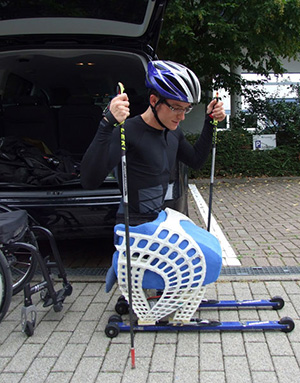The Paralympic Winter Games, much like the Paralympic Games in general, have been taking place regularly, right after the Summer and Winter Olympic Games, since 1988. Although the audience has been growing, through the participation of star athletes such as Oscar Pistorius and Alex Zanardi, the total viewers and sponsor support is still far from that gathered by the Olympics. That means that, paradoxically, while regular olympic athletes often receive custom made, expensive equipment, paralympic athletes, who would most benefit from tailored supports, have to adapt to equipment that is still being developed through costly and inefficient methods.
This is starting to change, however, in no small way due to the increasing adoption of additive manufacturing technologies, as demonstrated by the new Snowstorm project, undertaken by the Fraunhofer Institute for Mechanics of Materials (IWM). With help from German biathlete Martin Felig, scientists from the famed institute (not new to 3D printed endeavours) developed a sit-down-ski set specifically designed to withstand forces during descent and adapted it to fit all his requirements, through the comparatively low cost digital manufacturing laser sintering process. Fleig will use the sit-down-skis to compete at the upcoming Paralympic Games in Sochi, starting March 7th.
These particular skis had to be developed taking into consideration a wide variety of factors, including many types of stress the athlete undergoes over uneven cross-country snow. The first phase of the Snowstorm project was thus dedicated to collecting 3D biometric data of Felig’s movements to ascertain his optimal seating position. “Our aim for the project is to find ways to design sit skis that can be tailored to any athlete while also making the process as cost-effective as possible,” explained Fraunhofer scientist Professor Scherge. “As the extent and nature of physical impairment is unique to each individual, athletes must be able to achieve the very specific position in which they can unleash their full potential.”
The first prototype was manufactured using polyamide 12 high-performance polymer and fitted with sensors to measure stresses occurring during use. Through the data collected, the Fraunhofer scientists developed a second prototype (by simply modifying the digital model and “sintering out” a new physical model). This second reinforced model was then tried and pushed to its limits by Fleig at the at the Notschrei Nordic Center in Germany’s Black Forest and at the altitude training camp in Livigno, Italy.
As much as this is all still based on relatively advanced science, 3D printing is opening doors to custom made equipment like never before, especially for those who need it most. As the technologies will become more commonplace, paralympic athletes — as well as all athletes with disabilities — who are often capable of amazing performances even without proper equipment, will enter into a new era where obtaining any kind of tailor made support will be as easy as getting a 3D scan done, and as affordable as the plastic or metal (or both) it uses. Man-machine combination will become more common place and perhaps even the name of the Paralympics event might change to something with a broader mass appeal, the same way 3D printing substituted rapid prototyping and additive manufacturing: how about Cyberlympics?




